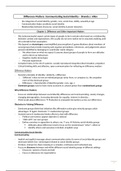Summary
Summary Difference Matters solutions of objectives
- Course
- Institution
- Book
This document contains: - Summary of the book 'Difference Matters' by Brenda J. Allen chapters 1, 2, 3 and 9 (in English) - Solutions for the objectives of the exam (in Dutch) - Linking between chapter 3 'Gender' and general concepts to be known (in Dutch) Course Intercultural Communication - Lect...
[Show more]




